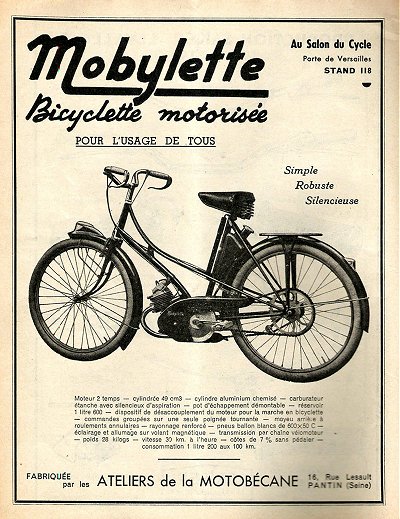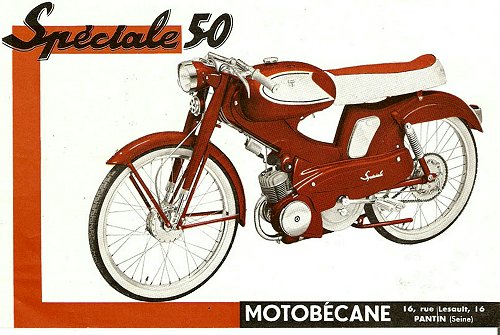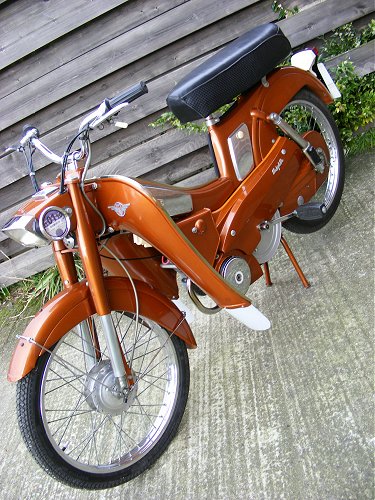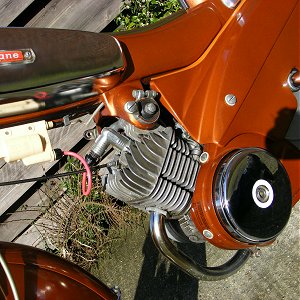


The first model of Mobylette
Motobécane introduced its first moped in 1949, calling it the ‘Mobylette’. A brand that would become widely familiar over the following decade as growing popularity of the machine practically turned it into a household name, but in reality, as the 1950s progressed, the beloved Moby was being left in the dust!
The problem was that Motobécane wasn’t the only moped manufacturer, and other makers were developing new models at a prodigious rate, so the Mobylette needed to evolve too.
Early Mobylettes were based on traditional tubular cycle frame brazed lug construction, which was superseded by the first pressed-steel, welded chassis assemblies for the AV76 from 1957.
By mid 1958 the new ‘Dimoby’ double clutch completely replaced the earlier so-called ‘automatic’ clutch that actually required the rider to ‘pedal-off’ to engage the drive. Now the operation was genuinely automatic.
AV77 & 78 models also introduced a variator system, where the motor swung against a spring as the engine revs increased, pushed back by centrifugally driven pulley, and raising the driving ratio by 39%. There was a lot of rider appeal in such a simple-to-operate, fully automatic, and effectively geared clutch and drive system—unfortunately it proved pretty disappointing when you rode these early ones!
What let this physical package down was that all these recent developments were still centred around the basic AV7 motor—with small transfer and exhaust ports, 6.5:1 compression ratio, and 10mm Gurtner carb, at 1.4bhp it couldn’t tear its way out of a wet paper bag!
Riding a standard AV76 certainly provides an appreciation of these limitations. The first variator systems were 6-ball operated, pretty much kicked up into high ratio almost as soon as you took off, gradually laboured up to pace, and failed to effect a ratio change when you encountered an incline. The only way you could get them to change back down at all was actually to stop! The feeble motor really struggled to build up any speed against headwinds or any incline, and generally offered little practical performance improvement over its non-variated siblings. The only small benefit of its motor constantly labouring against the high drive ratio, was that it was much less afflicted with the irritating bouts of 4-stroking that plagued the fixed-drive models at higher revs.
Motobécane attempted to address the ineffective variator by reducing the cast aluminium centrifugal cone to a 5-ball set on the later AV76s, but it made no difference, the variator still wasn’t variating, and the AV7 motor still wasn’t up to the job.
To give some impression how bad the Mobymatic speed-change variator was, you have to appreciate that by the time Motobécane finally got it working properly and effectively in the late 60s, the centrifugal cone was reduced to just 3-balls in a plastic moulded cage.
Early tubular frame Mobylettes were painted in uninspiring drab shades of ‘Gris Nuit’ (night grey), ‘Beige’, ‘Crème’, and ‘Mastic’ (putty grey). Though later machines did manage to introduce a hint of colour with their later ‘Bleu Foncé’ (dark blue), and ‘Bleu Clair’ (light blue) tones, the conservative block finishes effectively represented the bland personality of the models.
As the 1950s entered their closing year, the dated Mobylette machines of ’59 were hardly the models to carry the company forward into the competitive market of the next decade. No half-hearted revamp of the AV76 flagship with its obsolete plunger rear suspension and all its other failings would offer any prospect of salvation.
As the calendar counted down toward December’s end, it would seem that the situation required almost divine inspiration … and that’s exactly what the coming year would bring, as Motobécane delivered its new Bronze Age at the Paris Salon in October 1960—with the fantastic new ‘Grand Tourisme’ AV89!

AV89
brochure picture, October 1960
This machine was a whole fresh package, new engine, band suspended leading-link forks with swingarm rear suspension, pressed-steel frame, dual seat, and finished in awesome ‘Chaudron’ metallic bronze paint that glistened in the lights as if cast by the Gods!
Accompanied by the launch of a new flagship, the tele-forked Spéciale 50 model sport version was an artistic styling stunner—so now Mobylette was really ready to bring on the 60s!

Spéciale 50 brochure picture
After the gutless old AV7 engine, it might have seemed pretty brave for these machines to be equipped with a dual seat and footrests, fully intended for carrying two people, but the AV89 motor would prove everything it needed to be.
Restricted porting within the AV7 cylinder was 20×7mm exhaust, with 18×6mm transfers.
Developed porting of the AV89 cylinder was 20×11mm exhaust, with 18×8mm transfers.
From 6.5:1 compression, the AV89 head bumped this up to 9:1, and an H14mm Gurtner now replaced the BA10mm carb.
Up from just 1.4bhp at 4,500rpm, the dyno read out 2.66bhp, so enough power to overcome the performance issues, and a plastic centrifugal cone, 4-ball variator now allowed this system to operate appreciably better (though often still required a jolt from snapping on the back brake to induce the gearing to change down in preparation for a hill climb).
The old AV7 motor would probably barely rev much beyond its 4,500 rating before restrictive gas transfer limited its rev ceiling. With the AV89 motor, the bigger ports let this engine rev beyond and away into the clear blue. It wasn’t just about more power to forge against headwinds, up an incline, or pull with a pillion passenger aboard, but the ability to rev so freely also offered the potential of speed…
AV89 Luxamatic imports into the UK are listed from December 1960, joined by the Raleigh branded RM5 Supermatic version from February 1961, Norman Lido Mk3 and Phillips Gadabout Mk4 variants from September 1961. The Norman was de-listed in the autumn of 1963 and the Phillips model failed to return for 1964. Raleigh continued with the RM5 until September 1969, when the model was discontinued.

Our feature machine
AV89 imports stopped in September 1971, but the model was re-introduced in June 1975, which brings us to the feature machine for our article today, a magnificent example registered on 21st July 1976. The excellent original and preserved finish of this vehicle is explained by the remarkably low mileage, but there have been a few light tweaks to the motor with what looks like a 0.6mm lift on the cylinder to ‘fine trim’ the porting. It’s clearly running no head gasket and the face has been shaved for a compression increase from the standard 9:1 to probably around 10 or 11:1. The rear sprocket has also been switched from 48T down to 44T, so that’s an 8% ratio raise. These variations to enable more comfortable average cruising may be taken into account against a standard specification.
Push down the petrol tap knob for on.
Any expectation of a dual operation twistgrip with forward decompression function is dashed by the equipment of a separate thumb trigger decompressor lever under the throttle cluster, matched by a choke trigger under the left hand lever set. Foregoing the ‘kick on stand’ technique since the pedal ratio seems to work against the AV89 for this method, we opt for a leisurely flying start style. Pull in both levers, pedal off, the engine spins, tweak open the throttle and release the decomp, and the engine fires up straightaway. Just coast along at walking pace while thumbing the choke lever occasionally until the engine stops fading, then throttle away.

The AV89
engine
The higher ratio drive creates a bit of a flat spot on initial pull away, but the engine swings back as the variator kicks up, while the revs remain flat throughout the auto-change. There’s a smooth and constant urge up the range, which quickly and easily glides us up to town pace, and work the motor up to temperature as we cruise out of the urban area.
Balance and handling are plainly excellent as the cycle flows naturally along the sweeping green lanes, and you can take both hands off the bars without even a thought as the bike confidently continues ahead as if guided by some magical auto-pilot.
With the legshield set removed for the road test, in still air conditions and rider upright we managed to read up about 41, but once again the Huret speedo proved faster than the moped as our pace bike clocked this section off at 36-37mph. Crouched on flat encouraged the needle round to 43, while the pace bike read this off at 38-39mph. Burning a couple of downhill runs in full crouch, as best of both directions, the needle pushed up to 52 with the pacer tracking at 43-44mph.

The AV89
engine
Though that proved the most we could wring out of this bike, the AV89 motor handled it completely unconcernedly, and gave the impression it could happily run like that all day. With only 1,088 genuine miles on the clock, this bike still has its best days to come as the motor loosens up to rev as freely as an AV89 can.
On the climb, the raised ‘cruise’ gearing would obviously work against this particular AV89, and its speed quickly dropped off against an incline as it laboured hard against the now adverse ratio.
The big rectangular glass lens of the 130×80mm Luxor 142 6V×18/18W headlamp made about the best light you might reasonably expect from the 21W Novi generator, but the AV89’s pace was such that you’d probably find yourself getting into trouble if you started trying to exploit the bike’s full potential on dark country lanes.
On 1st August 1977, UK law changed the definition of a moped to ‘a machine limited to 30mph’, and deleted the requirement for it to be equipped with pedals. The revision permitted a ‘period of grace’, allowing dealers to clear existing stocks, and the AV89 model de-listed in June 1978.

A last look at the AV89
Imports resumed in March 1979, though now presumably restricted by some means to comply with the legislation. Cylinders of these later ‘Sloped’ compliant versions reportedly feature a return to smaller porting, but it appeared of little consequence since few seem to have been sold and these late dated examples are very rarely encountered. The AV89 continued on listings up to 1982, when the model was withdrawn, but the Bronze Age had really passed in the previous decade.
Next: Time is calling once again as a cold gust of wind blows down the street, scattering leaves from the gutters and bowling a crumpled paper along the pavement. Unfolding the ball, we find it is another poster for "The Autocycle Roadshow—Second Act of our tale of traditional cycle industries … closing down, final week."
We must return to Birmingham!
With every footfall, our sodden shoes momentarily splash the puddles from the pavement, while the unceasing rain follows our steps to fill them again. Finally, ahead, the dim lamps of the crumbling theatre beckon from the evening gloom. Buying our tickets at the kiosk, a few spare coins stretch to a new pack of cigarillos and box of strikes, and the musty dampness of the foyer is replaced by the comforting aroma of tobacco as we stumble down the dark passage to the auditorium. Our spines tingle with anticipation as we take our seats in the post-war decade, and light our smokes to while away the minutes before the start of the show…
Now things might start to get confusing, as the forthcoming support feature picks up where the main feature left off in the previous issue! The threads of our stories continue to weave their tangled web.
[Text and photos © 2009 M Daniels. Period documents from IceniCAM Information Service.]
The loan of a superb and genuine low-mileage Mobylette AV89 from Paul Efreme in Essex offered a smart opportunity to produce a long overdue feature on one of history’s truly great mopeds. While there’s plenty of hard-worked, rough and rusty examples still running around, it’s pretty rare to come across many in such fabulous original condition. In a few rays of sunshine, the stunning ‘Chaudron’ paint just comes alive, and the bike leaps out from a simple neutral shade background to make the photoshoot really easy—it’s hard to take a bad picture of such a good bike.
Once thought up, the Bronze Age title so suited the article, and seemed to neatly follow on from the preceding Golden Helmet Patria feature. With a moped article required to balance up the magazine content, Bronze Age was fast-tracked to publication as a complete 2009 production.
The AV89 was a great bike at just the right time for Motobécane and, still being listed over 20 years later, illustrates why it stands so proudly in the moped hall of fame.
Production costs of Bronze Age were also very reasonable, just £25 for fuel, since pictures were all shot in digital. This sponsorship opportunity was snapped up by one of our regular supporters: keen Moby enthusiast Lindsay Neill.
| CAMmag Home Page | List of articles |